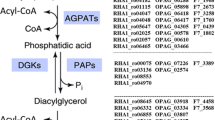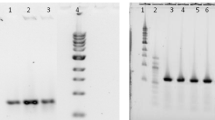Abstract
Rhodococcus opacus PD630 is an oleaginous bacterium able to accumulate large amounts of triacylglycerols (TAG) in different carbon sources. The last reaction for TAG biosynthesis is catalyzed by the bifunctional wax ester synthase/acyl-CoA:diacylglycerol acyltransferase (WS/DGAT) enzymes encoded by atf genes. R. opacus PD630 possesses at least 17 putative atf homologous genes in its genome, but only atf1 and atf2 exhibited a significant DGAT activity when expressed in E. coli, as revealed in a previous study. The contribution of atf1 gene to TAG accumulation by strain PD630 has been demonstrated previously, although additional Atfs may also contribute to lipid accumulation, since the atf1-disrupted mutant is still able to produce significant amounts of TAG (Alvarez et al., Microbiology 154:2327–2335, 2008). In this study, we investigated the in vivo role of atf2 gene in TAG accumulation by R. opacus PD630 by using different genetic strategies. The atf2-disrupted mutant exhibited a decrease in TAG accumulation (up to 25–30 %, w/w) and an approximately tenfold increase in glycogen formation in comparison with the wild-type strain. Surprisingly, in contrast to single mutants, a double mutant generated by the disruption of atf1 and atf2 genes only showed a very low effect in TAG and in glycogen accumulation under lipid storage conditions. Overexpression of atf1 and atf2 genes in strain PD630 promoted an increase of approximately 10 % (w/w) in TAG accumulation, while heterologous expression of atf2 gene in Mycobacterium smegmatis caused an increase in TAG accumulation during cultivation in nitrogen-rich media. This study demonstrated that, in addition to atf1 gene, atf2 is actively involved in TAG accumulation by the oleaginous R. opacus PD630.






Similar content being viewed by others
References
Alvarez HM (2010) Biotechnological production and significance of triacylglycerols and wax esters. In: Timmis KN (ed) Microbiology of hydrocarbons, oils, lipids, and derived compounds, vol 3. Springer, Heidelberg, pp 2995–3002
Alvarez HM, Steinbüchel A (2002) Triacylglycerols in prokaryotic microorganisms. Appl Microbiol Biotechnol 60:367–376
Alvarez HM, Steinbüchel A (2010) Physiology, biochemistry and molecular biology of triacylglycerol accumulation by Rhodococcus. In: Alvarez HM (ed) Biology of Rhodococcus. Microbiology monographs series. Springer, Heidelberg, pp 263–290
Alvarez HM, Mayer F, Fabritius D, Steinbüchel A (1996) Formation of intracytoplasmic lipid inclusion by Rhodococcus opacus PD630. Arch Microbiol 165:377–386
Alvarez HM, Kalscheuer R, Steinbüchel A (1997) Accumulation of storage lipids in species of Rhodococcus and Nocardia and effect of inhibitors and polyethylene glycol. Fett-Lipid 99:239–246
Alvarez AF, Alvarez HM, Kalscheuer R, Wältermann M, Steinbüchel A (2008) Cloning and characterization of a gene involved in triacylglycerol biosynthesis and identification of additional homologous genes in the oleogenous bacterium Rhodococcus opacus PD630. Microbiology 154:2327–2335
Arabolaza A, Rodriguez E, Altabe S, Alvarez H, Gramajo H (2008) Multiple pathways for triacylglycerol biosynthesis in Streptomyces coelicolor. Appl Environ Microbiol 74:2573–2582
Arabolaza A, D'Angelo M, Comba S, Gramajo H (2010) FasR, a novel class of transcriptional regulator, governs the activation of fatty acid biosynthesis genes in Streptomyces coelicolor. Mol Microbiol 78(1):47–63
Barksdale L, Kim KS (1977) Mycobacterium. Bacteriol Rev 41:217–372
Brandl H, Gross RA, Lenz RW, Fuller RC (1988) Pseudomonas oleovorans as a source of poly(b-hydroxyalkanoates) for potential applications as biodegradable polyesters. Appl Environ Microbiol 54:1977–1982
Daniel J, Deb C, Dubey VS, Sirakova T, Abomoelak MHR, Kolattukudy PE (2004) Induction of a novel class of diacylglycerol acyltransferases and triacylglycerol accumulation in Mycobacterium tuberculosis as it goes into a dormancy-like state in culture. J Bacteriol 186:5017–5030
Dhiman RK, Schulbach MC, Mahapatra S, Baulard AR, Vissa V, Brennan PJ, Crick DC (2004) Identification of a novel class of ω, E, E-farnesyl diphosphate synthase from Mycobacterium tuberculosis. J Lipid Res 45:1140–1147
Duncombe WG (1963) The colorimetric micro-determination of long chain fatty acids. Biochem J 88:7
Gouda MK, Omar SH, Aouad LM (2008) Single cell oil production by Gordonia sp. DG using agro-industrial wastes. World J Microbiol Biotechnol 24:1703–1711
Gregory MA, Till R, Smith MC (2003) Integration site for Streptomyces phage phiBT1 and development of site specific integrating vectors. J Bacteriol 185:5320–5323
Hanahan D (1983) Studies on transformation of Escherichia coli with plasmids. J Mol Biol 166:557–580
Hänisch J, Wältermann M, Robenek H, Steinbüchel A (2006a) The Ralstonia eutropha H16 phasin PhaP1 is targeted to intracellular triacylglycerol inclusions in Rhodococcus opacus PD630 and Mycobacterium smegmatis mc2155, and provides an anchor to target other proteins. Microbiology 152:3271–3280
Hänisch J, Wältermann M, Robenek H, Steinbüchel A (2006b) Eukaryotic lipid body proteins in oleogenous actinomycetes and their targeting to intracellular triacylglycerol inclusions: impact on models of lipid body biogenesis. Appl Environ Microbiol 72:6743–6750
Hernández MA, Alvarez HM (2010) Glycogen formation by Rhodococcus species and the effect of inhibition of lipid biosynthesis on glycogen accumulation in Rhodococcus opacus PD630. FEMS Microbiol Lett 312:93–99
Hernández MA, Mohn WW, Martínez E, Rost E, Alvarez AF, Alvarez HM (2008) Biosynthesis of storage compounds by Rhodococcus jostii RHA1 and global identification of genes involved in their metabolism. BMC Genomics 12:600
Holder JW, Ulrich JC, DeBono AC, Godfrey PA, Desjardins CA, Zucker J, Zeng Q, Leach ALB, Ghiviriga I, Dancel C, Abeel T, Gevers D, Kodira CD, Desany B, Affourtit JP, Birren BW, Sinskey AJ (2011) Comparative and functional genomics of Rhodococcus opacus PD630 for biofuels development. PLoS Genet 7(9):e1002219. doi:10.1371/journal.pgen.1002219
Holtzapple E, Schmidt-Dannert C (2007) Biosynthesis of isoprenoid wax ester in Marinobacter hydrocarbonoclasticus DSM 8798: identification and characterization of isoprenoid coenzyme A synthetase and wax ester synthases. J Bacteriol 189(10):3804–3812
Kalscheuer R, Steinbüchel A (2003) A novel bifunctional wax ester synthase/acyl-CoA: diacylglycerol acyltransferase mediates wax ester and triacylglycerol biosynthesis in Acinetobacter calcoaceticus ADP1. J Biol Chem 278:8075–8082
Kalscheuer R, Arenskötter M, Steinbüchel A (1999) Establishment of a gene transfer system for Rhodococcus opacus PD630 based on electroporation and its application for recombinant biosynthesis of poly(3-hydroxyalkanoic acids). Appl Microbiol Biotechnol 52:508–515
Kalscheuer R, Stoveken T, Malkus U, Reichelt R, Golyshin PN, Sabirova JS, Ferrer M, Timmis KN, Steinbüchel A (2007) Analysis of storage lipid accumulation in Alcanivorax borkumensis: evidence for alternative triacylglycerol biosynthesis routes in bacteria. J Bacteriol 189:918–928
Leman J (1997) Oleaginous microorganisms: an assessment of the potential. Adv Appl Microbiol 43:195–243
Li Q, Du W, Liu D (2008) Perspectives of microbial oils for biodiesel production. Appl Microbiol Biotechnol 80:749–756
Nakashima N, Tamura T (2004) Isolation and characterization of a rolling-circle-type plasmid from Rhodococcus erythropolis and application of the plasmid to multiple-recombinant-protein expression. Appl Environ Microbiol 70:5557–5568
Olukoshi ER, Packter NM (1994) Importance of stored triacylglycerols in Streptomyces: possible carbon source for antibiotics. Microbiology 140:931–943
Pelicic V, Jackson M, Reyrat JM, Jacobs WR Jr, Gicquel B, Guilhot C (1997) Efficient allelic exchange and transposon mutagenesis in Mycobacterium tuberculosis. Proc Natl Acad Sci USA 94:10955–10960
Ratledge C (1989) Biotechnology of oils and fats. In: Ratledge SG, Wilkinson (eds) Microbial lipids. Academic, London, pp 567–650
Salzman V, Mondino S, Sala C, Cole ST, Gago G, Gramajo H (2010) Transcriptional regulation of lipid homeostasis in mycobacteria. Mol Microbiol 78(1):64–77
Schlegel HG, Kaltwasser H, Gottschalk G (1961) Ein Submersverfahren zur Kultur Wasserstoff oxydierender Bakterien: Wachstumsphysiologische Untersuchungen. Arch Mikrobiol 38:209–222
Triccas JA, Parish T, Britton WJ, Giquel B (1998) An inducible expression system permitting the efficient purification of a recombinant antigen from Mycobacterium smegmatis. FEMS Microbiol Lett 167:151–156
Van der Geize R, Hessels GI, Van Gerwen R, Vrijbloed JW, Van der Meijden P, Dijkhuizen L (2000) Targeted disruption of the kstD gene encoding a 3-ketosteroid Δ1-dehydrogenase isoenzyme of Rhodococcus erythropolis strain SQ1. Appl Environ Microbiol 66:2029–2036
Wältermann M, Luftmann H, Baumeister D, Kalscheuer R, Steinbüchel A (2000) Rhodococcus opacus PD630 as a source of high-value single cell oil? Isolation and characterization of triacylgycerols and other storage lipids. Microbiology 146:1143–1149
Wawrik B, Harriman BH (2010) Rapid, colorimetric quantification of lipid from algal cultures. J Microbiol Methods. doi:10.1016/j.minet.2010.01.016
Acknowledgments
The authors thank W.W. Mohn for the provision of pTip-QC2 vector. This study was financially supported by the SCyT of the University of Patagonia San Juan Bosco, the Agencia Comodoro Conocimiento (MCR), Oil m&s and PICT-2008-1640. H.M. Alvarez is a career investigator and M.A. Hernández a scholarship holder of the Consejo Nacional de Investigaciones Científicas y Técnicas (CONICET), Argentina.
Author information
Authors and Affiliations
Corresponding author
Electronic supplementary material
Below is the link to the electronic supplementary material.
ESM 1
(PDF 885 kb)
Rights and permissions
About this article
Cite this article
Hernández, M.A., Arabolaza, A., Rodríguez, E. et al. The atf2 gene is involved in triacylglycerol biosynthesis and accumulation in the oleaginous Rhodococcus opacus PD630. Appl Microbiol Biotechnol 97, 2119–2130 (2013). https://doi.org/10.1007/s00253-012-4360-1
Received:
Revised:
Accepted:
Published:
Issue Date:
DOI: https://doi.org/10.1007/s00253-012-4360-1




